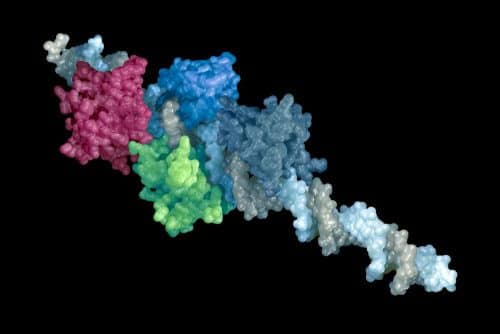The findings: In the experiments performed on the "Azurin" protein, the institute's scientists identified phenomena such as tunneling and compensation, which allowed the protein to behave more like a special electrical conductor, and less like a biological substance.

The question: How do proteins conduct electricity?
Scientists from the Weizmann Institute of Science recently showed that, although proteins are relatively large molecules, it seems that when it comes to the processes of conduction of electric currents, quantum phenomena take place in them. The research, which was recently published in the scientific journal Advanced Science, was carried out as part of a multidisciplinary collaboration between Prof. David Kahan from the Department of Materials and Surfaces, Prof. Mordechai (Mudi) Shaves from the Department of Organic Chemistry, Prof. Israel Pecht from the Department of Immunology, the researcher Doctoral Dr. Nadav Amdorski, and (then) research student Dr. Lior Sponero, all from the Weizmann Institute of Science.
The research group has shown in the past, using creative chemical processes, that many proteins are capable of being used as electrical conductors, and even of conducting a current with greater strength than expected, similar to the strength of the current in semiconductors, such as those used in the computer industry or other electrical devices. Among the other proteins, the scientists studied a protein called "Azurin", which contains copper in its active site, which was isolated from bacteria, in which it serves as an electron carrier in the cell's energy conversion cycle. In Prof. Pecht's previous studies, it was found that electrons are able to move within this protein for distances of up to three nanometers; That is, most of the length of the protein.
The scientists separated the azorin from its natural environment, i.e. from an aqueous solution, and measured its conductivity in a "dry" system, when the protein is between two electrical contacts. They tested how temperature changes of the order of hundreds of degrees or removing the copper ion, replacing it with other metal ions, or even replacing the water molecules associated with its outer shell with "heavy" water molecules, affect the conduction of electric currents by the protein. In its natural form (ie when it contains the copper ion), azorin conducts much better than any other configuration. But above all, and to their surprise, the scientists discovered that exposing the natural protein to a wide range of temperatures did not cause a change in its ability to conduct currents. In other words, the azorine behaved more like special electrical conductors than as a biological material.
Prof. Kahn believes that the lack of dependence of conductivity on temperature may be the result of a quantum phenomenon called "tunneling". Through quantum tunneling, an electron can pass through a barrier that, according to the classical laws of physics, it is unable to cross. Quantum phenomena such as tunneling are usually observed in small particles, or in systems that include a few atoms. Proteins, on the other hand, are large molecules, containing thousands of atoms. Because of this, many scientists believed that in proteins, as a system, it is unlikely that quantum phenomena will occur in regards to the transfer of electrons. The discovery that quantum phenomena occur in proteins and biological systems may help in the development of this new field of research in biophysics and biotechnology.
Furthermore, the scientists discovered that the conductivity level of Azorin indicates a phenomenon known as "compensation": that is, if an electron encounters an energy barrier, additional possibilities open up to help it pass the barrier. This phenomenon is more familiar in "normal" semiconductor materials, such as metal oxides. The "compensation point" - the temperature at which all versions of the protein conduct electrons with the same efficiency - occurred when the natural protein reached a temperature where it loses its three-dimensional structure, and therefore stops functioning. It was found that the azorin also works according to the principles of compensation, and the current at the compensation point for all protein versions will be the same as that of the natural protein. Therefore, the current level of the protein in its natural state becomes the highest current that can pass through all versions of the protein. "It seems almost as if nature is providing us with clues to the way in which proteins such as azurin function," says Prof. Kahn. "One of the things we learned is that it seems that the natural structure in which the protein is folded - and the way in which the copper ion is bound - are essential for its activity, and its ability to conduct an electric current. It is possible that the folding creates an ideal frame, which optimizes the conductivity".
The scientists hope that the results of this research will indeed inspire new ideas about the way proteins work as tiny biological machines. "Evolution gave us proteins, which we found that for reasons we still don't fully understand, they are able to conduct electricity with surprising efficiency," says Prof. Pecht. "The charm, appeal and benefits of using proteins come from the fact that we can change them in a wide variety of ways, and thereby adapt them to the wide variety of our ideas and needs."
Science books
With the help of the "azorin" protein, electrons can pass a distance of 3.5 nanometers.
Tags:
David Kahan, Department of Immunology, Department of Materials and Surfaces, Department of Organic Chemistry, Azorin Protein, Copper Ion Conducting Protein, Israel Pechtminhor, Mordechai Shaves, Compensation Point
